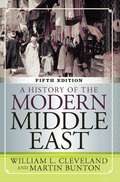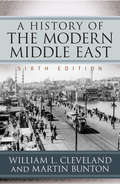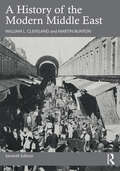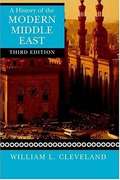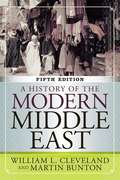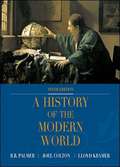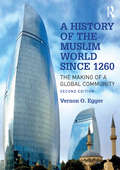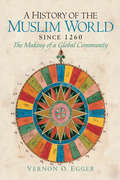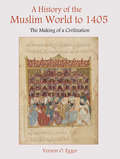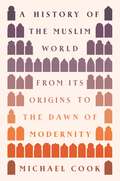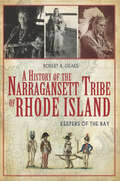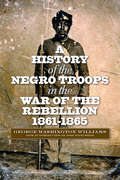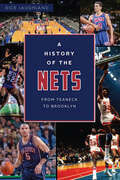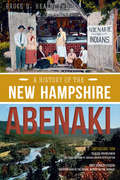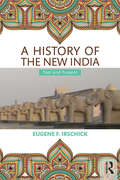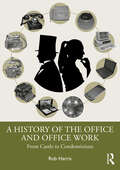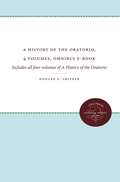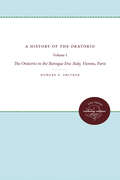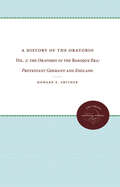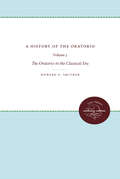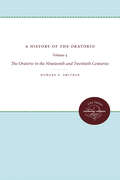- Table View
- List View
A History of the Modern Middle East
by William L. Cleveland Martin BuntonThis comprehensive work provides a penetrating analysis of modern Middle Eastern history, from the Ottoman and Egyptian reforms, through the challenge of Western imperialism, to the impact of US foreign policies. After introducing the reader to the region’s history from the origins of Islam in the seventh century, A History of the Modern Middle East focuses on the past two centuries of profound and often dramatic change. Although built around a framework of political history, the book also carefully integrates social, cultural, and economic developments into a single, expertly crafted account. In updating this fifth edition of the late William Cleveland’s popular introductory text, Martin Bunton provides a thorough account of the major transformative developments over the past four years, including a new chapter on the tumultuous Arab uprisings and the participation of Islamist parties in a new political order in the Middle East.
A History of the Modern Middle East
by William L. Cleveland Martin BuntonA History of the Modern Middle East examines the profound and often dramatic transformations of the region in the past two centuries, from the Ottoman and Egyptian reforms, through the challenge of Western imperialism, to the impact of US foreign policies. Built around a framework of political history, while also carefully integrating social, cultural, and economic developments, this expertly crafted account provides readers with the most comprehensive, balanced and penetrating analysis of the modern Middle East.The sixth edition has been revised to provide a thorough account of the major developments since 2012, including the tumultuous aftermath of the Arab uprisings, the sectarian conflict in Iraq and civil war in Syria that led to the rise of ISIS, the crises in Libya and Yemen, and the United States' nuclear talks with Iran. With brand-new timelines in each part, updated select bibliographies, and expanded online instructor resources, A History of the Modern Middle East remains the quintessential text for courses on Middle East history.
A History of the Modern Middle East
by William L. Cleveland Martin BuntonA History of the Modern Middle East examines the profound and often dramatic transformations of the region in the past two centuries, from the Ottoman and Egyptian reforms, through the challenge of Western imperialism, to the impact of US foreign policies. Built around a framework of political history, while also carefully integrating social, cultural, and economic developments, this expertly crafted account provides readers with the most comprehensive, balanced, and penetrating analysis of the modern Middle East.The seventh edition has been substantially revised to reflect the significance of the 2011 Arab Uprisings as a major turning point in the modern history of the region. A new chapter considers how regional powers, especially in the Gulf, are now asserting themselves more forcefully, seeking to push their own interests while Russia and China contest America’s position. Including an annotated and updated bibliography that offers guidance to readers seeking more in-depth information and incorporating an online companion website featuring quizzes, timelines, and instructor resources, A History of the Modern Middle East remains the quintessential text for courses on Middle Eastern history.
A History of the Modern Middle East (Third Edition)
by William L. ClevelandFrom the preface: This book is intended to introduce Middle Eastern history to students and general readers who have not previously studied the subject. In the pages that follow, the term Middle East refers to the region from Egypt in the west through Iran in the east, and from Turkey in the north to the Arabian Peninsula in the south. I am aware that sound arguments exist for extending the geographical coverage to include Arab North Africa, the Sudan, and Islamic Afghanistan. However, for purposes of coherence and manageability, I concentrate on the central Middle East and therefore have eliminated from this edition the section on the independent Islamic republics of Central Asia. The primary chronological focus of the book is from the late eighteenth to the early twenty-first centuries. Most of the chapters in Part Five have been revised, reorganized, and updated. Thus, Chapter 23 introduces the second intifada and attempts to place it in both its local and regional contexts, and Chapter 24 examines the impact of the election of an Islamist-oriented majority government in Turkey in 2002 as well as the significance of the clash between Iranian President Khatami's efforts to introduce reforms and the established ulama's ability to maintain the status quo. And finally, although this book is an examination of the past, not of the present or the future, the dramatic events of September 11, 2001, and the US military actions in Afghanistan and Iraq to which those events gave rise warranted, in my opinion, some analysis, however tentative and incomplete. This I have provided in an Epilogue.
A History of the Modern Middle East Fifth Edition
by William L. Cleveland Martin BuntonThis comprehensive work provides a penetrating analysis of modern Middle Eastern history, from the Ottoman and Egyptian reforms, through the challenge of Western imperialism, to the impact of US foreign policies. After introducing the reader to the region's history from the origins of Islam in the seventh century,A History of the Modern Middle East focuses on the past two centuries of profound and often dramatic change. Although built around a framework of political history, the book also carefully integrates social, cultural, and economic developments into a single, expertly crafted account. In updating this fifth edition of the late William Cleveland's popular introductory text, Martin Bunton provides a thorough account of the major transformative developments over the past four years, including a new chapter on the tumultuous Arab uprisings and the participation of Islamist parties in a new political order in the Middle East.
A History of the Modern Middle East: Rulers, Rebels, and Rogues
by Betty AndersonA History of the Modern Middle East offers a comprehensive assessment of the region, stretching from the fourteenth century and the founding of the Ottoman and Safavid empires through to the present-day protests and upheavals. The textbook focuses on Turkey, Iran, and the Arab countries of the Middle East, as well as areas often left out of Middle East history--such as the Balkans and the changing roles that Western forces have played in the region for centuries--to discuss the larger contexts and influences on the region's cultural and political development. Enriched by the perspectives of workers and professionals; urban merchants and provincial notables; slaves, students, women, and peasants, as well as political leaders, the book maps the complex social interrelationships and provides a pivotal understanding of the shifting shapes of governance and trajectories of social change in the Middle East. Extensively illustrated with drawings, photographs, and maps, this text skillfully integrates a diverse range of actors and influences to construct a narrative of the region that is at once sophisticated and lucid. A History of the Modern Middle East highlights the complexity and variation of the region, countering easy assumptions about the Middle East, those who governed, and those they governed--the rulers, rebels, and rogues who shaped a region.
A History of the Modern World (10th edition)
by R. R. Palmer Joel Colton Lloyd KramerMultiple levels of human history have created modern societies and exerted wide influence on people and cultures around the world. This book therefore describes the histories of specific nations and people and emphasizes landmark events such as wars and revolutions, but it also stresses broad historical trends that have developed deep below the most prominent historical events and created what we now call "the modern world."
A History of the Modern World (9th edition)
by Joel Colton R. R. Palmer Lloyd KramerThis book is for readers who will live in a new century of worldwide economic, political, and cultural interactions. The book goes beyond the histories of specific nations and people to describe broad historical trends that have affected people throughout the modern world. The authors have sought to explain the rise of nation-states and the global conflicts that have molded the world's diverse societies over the last several centuries, and has emphasized the evolving global economy, the importance of science and technology, the significance of religious traditions, the international diffusion of new ideas, the changing mores of social life, and the complex relations between Western cultures and other cultures around the world.
A History of the Muslim World since 1260: The Making of a Global Community
by Vernon O EggerA History of the Muslim World since 1260 continues the narrative begun by A History of the Muslim World to 1750 by tracing the development of Muslim societies, institutions, and doctrines from the time of the Mongol conquests through to the present day. It offers students a balanced coverage of Muslim societies that extend from Western Europe to Southeast Asia. Whereas it presents a multifaceted examination of Muslim cultures, it focuses on analysing the interaction between the expression of faith and contemporary social conditions. This extensively updated second edition is now in full colour, and the chronology of the book has been extended to include recent developments in the Muslim world. The images and maps have also been refreshed, and the literature has been updated to include the latest research from the last 10 years, including sections dedicated to the roles and status of women within Muslim societies throughout history. Divided chronologically into three parts and accompanied by a detailed glossary, A History of the Muslim World since 1260 is a perfect introduction for all students of the history of Muslim societies.
A History of the Muslim World since 1260: The Making of a Global Community
by Vernon O. EggerThe history of the predominantly Muslim world is examined within the context of world history. It examines political, economic, and broad cultural developments, as well as specifically religious ones. The themes of the book are tradition and adaptation: it examines the tensions between the desire of Muslims to maintain continuity with their legacy and their recognition of the need to adapt to changing conditions.
A History of the Muslim World to 1405: The Making of a Civilization
by Vernon O EggerMuslims first appeared in the early seventh century as members of a persecuted religious movement in a sun-baked town in Arabia. Within a century, their descendants were ruling a vast territory that extended from the Atlantic Ocean to the Indus River valley in modern Pakistan. This region became the arena for a new cultural experiment in which Muslim scholars and creative artists synthesized and reworked the legacy of Rome, Greece, Iran, and India into a new civilization. A History of the Muslim World to 1405 traces the development of this civilization from the career of the Prophet Muhammad to the death of the Mongol emperor Timur Lang. Coverage includes the unification of the Dar a1-Islam (the territory ruled by Muslims), the fragmentation into various religious and political groups including the Shi'ite and Sunni, and the series of catastrophes in the twelfth and thirteenth centuries that threatened to destroy the civilization. Features: Balanced coverage of the Muslim world encompassing the region from the Iberian Peninsula to South Asia. Detailed accounts of all cultures including major Shi'ite groups and the Sunni community. Primary sources. Numerous maps and photographs featuring a special four-color art insert. Glossary, charts, and timelines.
A History of the Muslim World to 1750: The Making of a Civilization
by Vernon O. EggerA History of the Muslim World to 1750 traces the development of Islamic civilization from the career of the Prophet Muhammad to the mid-eighteenth century. Encompassing a wide range of significant events within the period, its coverage includes the creation of the Dar al-Islam (the territory ruled by Muslims), the fragmentation of society into various religious and political groups including the Shi'ites and Sunnis, the series of catastrophes in the twelfth and thirteenth centuries that threatened to destroy the civilization, and the rise of the Ottoman, Safavid, and Mughal empires. Including the latest research from the last ten years, this second edition has been updated and expanded to cover the fifteenth to eighteenth centuries. Fully refreshed and containing over sixty images to highlight the key visual aspects, this book offers students a balanced coverage of the Muslim world from the Iberian Peninsula to South Asia, and detailed accounts of all cultures. The use of maps, primary sources, timelines, and a glossary further illuminates the fascinating yet complex world of the pre-modern Middle East. Covering art, architecture, religious institutions, theological beliefs, popular religious practice, political institutions, cuisine, and much more, A History of the Muslim World to 1750 is the perfect introduction for all students of the history of Islamic civilization and the Middle East.
A History of the Muslim World: From Its Origins to the Dawn of Modernity
by Michael A. CookA panoramic history of the Muslim world from the age of the Prophet Muḥammad to the birth of the modern eraThis book describes and explains the major events, personalities, conflicts, and convergences that have shaped the history of the Muslim world. The body of the book takes readers from the origins of Islam to the eve of the nineteenth century, and an epilogue continues the story to the present day. Michael Cook thus provides a broad history of a civilization remarkable for both its unity and diversity.After setting the scene in the Middle East of late antiquity, the book depicts the rise of Islam as one of the great black swan events of history. It continues with the spectacular rise of the Caliphate, an empire that by the time it broke up had nurtured the formation of a new civilization. It then goes on to cover the diverse histories of all the major regions of the Muslim world, providing a wide-ranging account of the key military, political, and cultural developments that accompanied the eastward and westward spread of Islam from the Middle East to the shores of the Atlantic and the Pacific.At the same time, A History of the Muslim World contains numerous primary-source quotations that expose the reader to a variety of acutely insightful voices from the Muslim past.
A History of the Narraganset Tribe of Rhode Island: Keepers of the Bay (American Heritage)
by Robert A. GeakeThe story of the indigenous people in what would become Rhode Island, their encounters with Europeans, and their return to sovereignty in the twentieth century. Before Roger Williams set foot in the New World, the Narragansett farmed corn and squash, hunted beaver and deer, and harvested clams and oysters throughout what would become Rhode Island. They also obtained wealth in the form of wampum, a carved shell that was used as currency along the eastern coast. As tensions with the English rose, the Narragansett leaders fought to maintain autonomy. While the elder Sachem Canonicus lived long enough to welcome both Verrazzano and Williams, his nephew Miatonomo was executed for his attempts to preserve their way of life and circumvent English control. Historian Robert A. Geake explores the captivating story of these Native Rhode Islanders.
A History of the Nations and Empires Involved and a Study of the Events Culminating in the Great Conflict
by Logan MarshallN/A
A History of the Negro Troops in the War of the Rebellion, 1861-1865
by John David Smith George Washington WilliamsA History of the Negro Troops in the War of the Rebellion, 1861–1865 (originally published in 1888) by pioneer African American historian George Washington Williams remains a classic text in African American literature and Civil War history. In this powerful narrative, Williams, who served in the U.S. Colored Troops, tells the battle experiences of the almost 200,000 black men who fought for the Union cause. Determined to document the contributions of his fellow black soldiers and to underscore the valor and manhood of his race, Williams gathered his material from the official records of U.S. and foreign governments and from the orderly books and personal recollections of officers commanding Negro troops during the American Civil War. <p><p> The new edition of this important text includes an introductory essay by the award-winning historian John David Smith. In his essay, Smith narrates and evaluates the book’s contents, analyzes its reception by contemporary critics, and evaluates Williams’s work within the context of its day and its place in current historiography.
A History of the Nets: From Teaneck to Brooklyn (Sports)
by Rick LaughlandRelive the Ups and Downs of the Storied Saga of the Nomadic NetsThe Nets have led a wandering existence spanning over five decades. The team has been known as the New Jersey Americans, New York Nets, New Jersey Nets and now Brooklyn Nets, while constantly relocating throughout the New York metropolitan area. Though often plagued by instability and futility, the franchise has celebrated iconic moments in the course of ABA and NBA history. Julius Erving's legendary play led the team to a pair of ABA titles in 1974 and 1976. The meteoric rise of European superstar Dražen Petrović followed by his tragic death in 1993 is etched into basketball fans' hearts worldwide. Jason Kidd's uncommon will steered New Jersey to back-to-back NBA Finals appearances in 2002 and 2003. An enlightening phone call from NBA commissioner David Stern in 1997 paved the way for the team's move to Brooklyn in 2012. Author Rick Laughland charts the brutal lows and exuberant highs throughout the history of the Nets.
A History of the New Hampshire Abenaki (American Heritage)
by Bruce D. Heald Chief Donald Stevens Rejean ObomsawinThe native Penacook, Winnipesaukee, Pigwacket, Sokoki, Cowasuck and Ossipee tribes, collectively known as the Abenaki, once thrived along the Granite State's great rivers. Influences of these "men of the east" abound today, from the boiling of sap for maple syrup to the game of lacrosse and traditional corn-and-bean succotash. Historian Bruce Heald has mined, curated and saved the real story of this land's first people. Learn the unwritten laws of hospitality, respect for the aged, honesty, independence and courtesy. Discover celebrations and innovations in the good times, later European disease epidemics and hostilities and a culture's enduring legacy.
A History of the New India: Past and Present
by Eugene F. IrschickProviding a different approach to the history of India than previously advocated, this textbook argues that there was constant interaction between peoples and cultures. This interactive, dialogic approach provides a clear understanding of how power and social relations operated in South Asia. Covering the history of India from Mughal times to the first years of Independence, the book consists of chapters divided roughly between political and thematic questions. Topics discussed include: Mughal warfare and military developments The construction of Indian culture Indian, regional and local political articulation India’s Independence and the end of British Rule Women and governmentality The rise of the Dalit movement As well as a detailed timeline that provides a useful overview of key events in the history of India, a set of background reading is included after each chapter for readers who wish to go beyond the remit of this text. Written in an accessible, narrative style, the textbook will be suitable in courses on Indian and South Asian history, as well as courses on world history and South Asian studies.
A History of the Office and Office Work: From Castle to Condominium
by Rob HarrisThis book brings together the office and office working as an economic construct, as a business function, as a building type and as a mode of work. It explores social and economic relations, and it traces the evolution of work and the environment and equipment needed to support it over the last 400 years. In so doing, it helps to fill a void in popular understanding of the office.The role of the office has been examined over the past three years in ways that it has never been examined before. Whilst the existential crisis arising from COVID-19 has settled somewhat, there remain big questions over the future of office workers and office real estate. This book is a timely, well-researched and fascinating contribution to the debate.Rob Harris explores how the nature of work has changed, and continues to change, placing the events surrounding COVID-19 into a longer-term perspective and asking what is the future of the office? Will it go through a radical reinvention? How will office work evolve in the future? Whither office buildings? The book emphasises the continuum of change and that today’s events are simply the latest stage of change, rather than something entirely novel.This book will be of interest to anyone with a stake in the built environment, whether as an investor, occupier, owner, manager or advisor. It is equally accessible to those with a non-technical background, including students on courses such as economic history, economics, geography, real estate and urban planning.
A History of the Oratorio, 4 volumes, Omnibus E-book
by Howard E. SmitherThe University of North Carolina Press is proud to announce Howard Smither's ground-breaking four-volume A History of the Oratorio, are now available in one convenient Omnibus E-Book edition. Published as UNC Press Enduring Editions, these volumes bring Smither's landmark scholarship to a new generation of readers and scholars.Written by an eminent scholar in a style that represents American musicological writing at its communicative best, A History of the Oratorio offers a synthesis and critical appraisal so exhaustive and reliable that the serious student of the oratorio will be compelled to look to these volumes as an indispensable source. No work on the history of the oratorio has yet appeared in the English language that is comparable in scope and treatment with Smither's comprehensive four-volume work.Volumes 1 and 2, published by the University of North Carolina Press in 1977, treated the oratorio in the Baroque era, while Volume 3, published in 1987, explored the genre in the Classical era. The final volume, Volume 4, published in 2000, surveys the history of nineteenth- and twentieth-century oratorio, stressing the main geographic areas of oratorio composition and performance: Germany, Britain, America, and France.A History of the Oratorio is the first full-length history of the genre since Arnold Schering published his Geschichte des Oratoriums in 1911. In addition to synthesizing current thought about the oratorio, these volumes contribute new information on relationships between oratorio librettos and contemporary literary and religious thought, and on the musical differences among oratorios from different geographical-cultural regions.Information on the 4 volumes included in this Omnibus E-Book:A HISTORY OF THE ORATORIOHoward E. SmitherVolume 1: The Oratorio in the Baroque Era: Italy, Vienna, Paris507 pp., 59 illus., 74 music examplesVolume 2: the Oratorio in the Baroque Era: Protestant Germany and England415 pp., 48 illus., 75 music examplesVolume 3: the Oratorio in the Classical Era736 pp., 37 illus., 30 tables, 110 music examplesVolume 4: The Oratorio in the Nineteenth and Twentieth Centuries856 pp., 24 illus., 33 tables, 90 figs.About UNC Press Enduring Editions UNC Press Enduring Editions use the latest in digital technology to make available again books from our distinguished backlist that were previously out of print. These editions are published unaltered from the original, and are presented in affordable paperback formats, bringing readers both historical and cultural value.
A History of the Oratorio: Vol. 1: The Oratorio in the Baroque Era: Italy, Vienna, Paris
by Howard E. SmitherHoward Smither has written the first definitive work on the history of the oratorio since Arnold Schering published his Geschichte des Oratoriums in 1911. This volume is the first of a four-volume comprehensive study that offers a new synthesis of what is known to date about the oratorio.Volume 1, divided into three parts, opens with the examination of the medieval, Renaissance, and early Baroque antecedents and origins of the oratorio, with emphasis on Rome and Philip Neri's Congregation of the Oratory and with special attention to the earliest works for which the term oratorio seems appropriate. The second part recounts the development of the oratorio in Italy, circa 1640-1720. It reviews the social contexts, patrons, composers, poets, librettos, and music of the oratorio in Italy, especially in Vienna and Paris. The procedure adapted throughout the work is to treat first the social context, particularly the circumstances of performance of the oratorio in a given area and period, then to treat the libretto, and finally the music. For each geographic area and period, the author has selected for special attention a few oratorios that appear to be particularly important or representative. He has verified the information offered in the specialized literature whenever possible by reference to the music or documents. In a number of areas, particular seventeenth-century Italy, in which relatively few previous studies have been undertaken or secondary sources have proven to be inadequate, the author has examined the primary sources in manuscript and printed form -- music, librettos, and documents of early oratorio history. Impressive research and intelligent integration of disparate elements make this complicated, diffuse subject both readable and accessible to the student of music.Volume 2, The Oratorio in the Baroque Era: Protestant Germany and England, and Volume 3, The Oratorio in the Classical Era, continue and expand the study of oratorio history. Although this series was originally announced as a three-volume study, Smither will conclude with a fourth volume.This new work--the first English-language study of the history of the oratorio will become the standard work on its subject and an enduring contribution to music and scholarship.Originally published in 1977.A UNC Press Enduring Edition -- UNC Press Enduring Editions use the latest in digital technology to make available again books from our distinguished backlist that were previously out of print. These editions are published unaltered from the original, and are presented in affordable paperback formats, bringing readers both historical and cultural value.
A History of the Oratorio: Vol. 2: the Oratorio in the Baroque Era: Protestant Germany and England
by Howard E. SmitherWritten by an eminent scholar in a style that represents American musicological writing at its communicative best, A History of the Oratorio offers a synthesis and critical appraisal so exhaustive and reliable that the serious student of the oratorio will be compelled to look to these volumes as an indispensable source. No work on the history of the oratorio has yet appeared in the English language that is comparable in scope and treatment with Howard Smither's comprehensive four-volume work.The first part of volume 2 examines in depth the antecedents and origins of the oratorio in Protestant Germany in the seventeenth century. It includes discussions of the Lutheran Historia, sacred dramatic dialogues, and the Lubeck Abendmusiken of Buxtehude. The second part treats the oratorio in Protestant Germany in the early eighteenth century and examines Handel, Reinhard Keiser, and J.S. Bach. The third part considers primarily the English oratorios of Handel. In most sections of A History of the Oratorio, the author has selected for special attention a few oratorios that are representative of each geographical area and period. An exception to this procedure is in the section on Handel in this volume, where all of the composer's English oratorios are treated fully with particular reference to recent specialized Handel studies.Volume 1, The Oratorio in the Baroque Era: Italy, Vienna, Paris, and Volume 3, The Oratorio in the classical Era, expand and continue the study of oratorio history. Although this series was originally announced as a three-volume study, Smither will conclude with a fourth volume.Originally published in 1977. A UNC Press Enduring Edition -- UNC Press Enduring Editions use the latest in digital technology to make available again books from our distinguished backlist that were previously out of print. These editions are published unaltered from the original, and are presented in affordable paperback formats, bringing readers both historical and cultural value.
A History of the Oratorio: Vol. 3: the Oratorio in the Classical Era
by Howard E. SmitherThe Oratorio in the classical Era is the third volume of Howard Smither's monumental History of the Oratorio, continuing his synthesis and critical appraisal of the oratorio. His comprehensive study surpasses in scope and treatment all previous works on the subject. A fourth and final volume, on the oratorio in the nineteenth and twentieth centuries, is forthcoming.In this volume Smither discusses the Italian oratorio from the 1720s to the early nineteenth century and oratorios from other parts of Europe from the 1750s to the nineteenth century. Drawing on works that represent various types, languages, and geographical areas, Smither treats the general characteristics of oratorio libretto and music and analyzes twenty-two oratorios from Italy, England, Germany, France, and Russia. He synthesizes the results of specialized studies and contributes new material based on firsthand study of eighteenth-century music manuscripts and printed librettos. Emphasizing the large number of social contexts within which oratorios were heard, Smither discussed examples in Italy such as the Congregation of the Oratory, lay contrafraternities, and educational institutions. He examines oratorio performances in German courts, London theaters and English provincial festivals, and the Parisian Concert spirituel. Though the volume concentrates primarily on eighteenth-century oratorio from the early to the late Classical styles, Smither includes such transitional works as the oratorios of Jean-Francios le Seur in Paris and Stepan Anikievich Degtiarev in Moscow.A History of the Oratorio is the first full-length history of the genre since Arnold Schering's 1911 study. In addition to synthesizing current thought about the oratorio, this volume contributes new information on relationships between oratorio librettos and contemporary literary and religious thought, and on the musical differences among oratorios from different geographical-cultural regions.Originally published in 1987.A UNC Press Enduring Edition -- UNC Press Enduring Editions use the latest in digital technology to make available again books from our distinguished backlist that were previously out of print. These editions are published unaltered from the original, and are presented in affordable paperback formats, bringing readers both historical and cultural value.
A History of the Oratorio: Vol. 4: The Oratorio in the Nineteenth and Twentieth Centuries
by Howard E. SmitherWith this volume, Howard Smither completes his monumental History of the Oratorio. Volumes 1 and 2, published by the University of North Carolina Press in 1977, treated the oratorio in the Baroque era, while Volume 3, published in 1987, explored the genre in the Classical era. Here, Smither surveys the history of nineteenth- and twentieth-century oratorio, stressing the main geographic areas of oratorio composition and performance: Germany, Britain, America, and France.Continuing the approach of the previous volumes, Smither treats the oratorio in each language and geographical area by first exploring the cultural and social contexts of oratorio. He then addresses aesthetic theory and criticism, treats libretto and music in general, and offers detailed analyses of the librettos and music of specific oratorios (thirty-one in all) that are of special importance to the history of the genre.As a synthesis of specialized literature as well as an investigation of primary sources, this work will serve as both a springboard for further research and an essential reference for choral conductors, soloists, choral singers, and others interested in the history of the oratorio.Originally published 2000.A UNC Press Enduring Edition -- UNC Press Enduring Editions use the latest in digital technology to make available again books from our distinguished backlist that were previously out of print. These editions are published unaltered from the original, and are presented in affordable paperback formats, bringing readers both historical and cultural value.
